This article originally appeared in The Competitive Paddler
*********
`Nice? It’s the ONLY thing,’ said the Water Rat solemnly, as he leant forward for his stroke. `Believe me, my young friend, there is NOTHING–absolute nothing–half so much worth doing as simply messing about in boats. ‘The Wind in the Willows’
I’m quite sure, had the Water Rat grown up in South Africa or Australia, the boats referred to would have been surfskis. Simple, unadorned by the flotsam and jetsam of gear stowage adopted by other forms of paddling, they are speed and grace distilled to its essence.
I too, moved up through the ranks of plastic-hulled, Tupperware-style craft, through sea kayaks and the like, to the carbon fiber Holy Grail of surfski. If this sounds remotely tongue in cheek, you are astute and observant, dear reader. Surfskis are merely another branch, albeit a decidedly slender one, in the ‘messing about in boats’ family tree, and one might argue, the former branches are essential to the latter. Prior to the more current designs, very few clambered immediately aboard one of these minimalist craft and were instantly proficient, or could even stay upright, for that matter. So, why surfskis? They are reputed to be tippy, fragile, and have little, if any, cargo capacity. Read on…
L’art du Surfski… The etymology of the moniker translates, quite literally, ‘to ski through the surf.’ Originally designed as rescue craft for lifeguards, their narrow profile enables them to slice through shore break, and their sit on top design facilitates ease of ingress or egress, with the ability to sling a rescued swimmer across the rear deck for transport to shore. The basic anatomy of a surfski dictates a long, narrow craft anywhere from 18 to 24 feet plus in length, with a beam of 16 to 22 inches, recesses for seat and footwells cleared of water by venturi drains, and an understern rudder steered via foot pedals. The understern rudder assures the ability to stay in the water on a wave face, carving turns with the precision of the proverbial hot knife through 0 grams of trans fat butter substitute. There exists little or no storage, save a small hatch or deck bungees. The range of surfskis has grown in recent years, comprising wider, more stable, craft (‘stable’ being a bit of an oxymoron where surfskis are concerned) to the highly tuned, thoroughbred race versions.
Granted, they’re not for everyone, but more and more everyones are gravitating to them, made easier by the aforementioned introduction of user-friendly designs. Used to be that the leap from a standard sea kayak to a ski was a quantum one. Being a strong swimmer was not necessarily a prerequisite, but was certainly an asset; unplanned swims were, and still are, the norm. However, modern designs offered by manufacturers have brought surfskis to the paddling masses. Anyone with basic kayak skills can swing a leg over and paddle away with a huge smile plastered on his or her face. Best mated to a wing paddle, they retain their simplicity of focus and minimalist beauty, yet no longer require the balance skills of Philippe Petit or the coordination and core strength of a gymnast to enjoy.
Skis are a wet ride. You are always sitting in water, yet it is this very quality that allows you to become one with it. As your stern lifts on a swell, propelling you to lightly skim down the trough of a wave, the water sizzles around you. Suddenly you are a tightrope walker at speed, working the dynamic energy of the swells, runner after runner, angling in with pinpoint precision for ride after ride. You hear shouting above the wind and the roar of the water, and it dawns on you that it is you who is whooping with delight. The endorphins run like the bulls at Pamplona, and your surfski is the vehicle of choice. But it doesn’t always start like that…
I took up paddling when my high school senior daughter was three, in a plastic Perception America with a child seat that slid neatly into the cockpit with the utility of a vacuum cleaner attachment. We tooled around local lakes, rivers, even the coastal estuaries of Cape Cod. Erin asked a plethora of questions, being an inquisitive, three year old-the view from the water is a captivating one-profoundly different from that of the land.
Father/daughter golden time aside, I found this water’s view element of perspective to be one I enjoyed immensely, to the degree that I began piloting our blue, plastic container out alone, for longer and longer distances. I had the fever. I purchased my first true sea kayak, a Perception Eclipse, and increased my speed, enabling me to go farther, somewhat faster. Then a Nigel Dennis Explorer, a true expedition boat, and learned how to roll. I logged my first race, the 19 mile Run of the Charles, shouldering that 67 lb. behemoth over six portages. Farther, yes, but nowhere near quick enough, or light enough. Years spent racing bicycles dictated I needed something with less mass and more velocity. A QCC700, Epic 18 Endurance, and eventually, a Westside EFT, were the obvious solutions, moving from one to the next in turn. I raced everything from lakes to rivers to open ocean. I trained hard. I saw results on the podium. Farther and faster. But still, not yet fast enough…
About this time, the father of one of the children in my fifth grade class (Jim, now a good friend and regular training partner) bought something called a ‘surfski.’ It was impossibly long, narrow, and featherlight. We promised to paddle together. I took notice of more and more of these sleek, minimalist craft populating the races. One of the primary pioneers of this surfski movement aside from the Beverly Boys in the northeast was Wesley Echols, a Rhode Island racer who was into, and I mean into, these new boats. Each event he’d be duct taping gel packs, prepping fastidiously, in the parking lot. Surfskis exuded a definitive air of ‘cool,’ and his signal orange (Orange?!) Huki S1-X screamed sheer velocity. With my need for speed, I needed to try me one of these. At a forward stroke clinic given by Danny Broadhurst in Long Island, Mike Tracy, a North Shore paddler, showed up with a brand spankin’ new Custom Kayaks Mark 1. Gosh darn, she was pretty. Refrigerator white with red racing stripes, she hearkened to my cartoon watching days of Speed Racer (‘Mark 1,’ ‘Mach 1’). Word had it this was a true South African boat. Ex-ot-ic.
Turns out I bought her. Several months after the clinic, word had it Mike was selling her, and she was just my size. Drove up to Beverly, MA, and picked her up. It was amongst the final days of September, and chilly, to say the least. Mike suggested I come up and race her my first time around Misery Island, cups of clam chowdah’ at the finish. I declined. In retrospect, this was an extremely prudent decision. I drove her home, polished her till she was sparkling, and rubbed my hands together in gleeful anticipation of taking her out for the first time on the local lake. With years of FSK racing prowess under my belt, this was to be a perfect mesh.
On my maiden voyage in a surfski, I wish I could claim I was a rock star. I can’t. I can reveal that late September water is quite bracing, and remounting for the first time without any direct instruction has a certain Keystone Cops quality to it, worthy of ‘America’s Funniest Home Videos.’ As befits any crushing failure, the first thing you wish to do is drag someone else along with you in your humiliation. I invited my friend, Steve, to have the next go. He wobbled perhaps twenty strokes before checking the algae content of our local lake as well. I never mastered that boat; I did improve to the point where I could keep her upright and put the power down on the flats, but an attempt out in Long Island Sound in 3 foot chop had me white-knuckled and silently whimpering for my mommy. After selling her, I vowed to never, ever paddle surfskis again; you were just so, so…exposed. Ironically, the Mark 1 has the reputation of being a user-friendly boat, and I’m quite sure I could easily handle her now. At the time, she was more than a hop, skip, and a jump away from where my skills (or lack thereof) were located. I was dating way out of my league.
I went back to my closed boats, but eventually, succumbed once again to peer pressure. Everyone, it seemed, was making the transition from closed boats to skis, including my tight circle of paddling peeps (“Et tu, Brute?”). The faster, closed boats lacked bulkheads, and had huge, wide-open cockpits to facilitate proper rotation, but were next to worthless if you dumped at sea and tried to roll them; you’d literally fall right out, and then be faced with pumping and dumping. Contrastingly, a ski always had its rudder on the wave, and if you ‘huli’d, you could scramble right back on. A Fenn XT, competent, but heavy and sluggish on the flats, was my next purchase. It was a fine boat; a sensible pair of shoes. Then I threw all caution to the wind and ordered up a brand new Huki S1-R, mango to red fades at the tip and tail, with black flame graphics, like a fifties era roadster. In the immortal words of ‘The Princess Bride’: “Twuuu love.” Dubbed ‘J.J. Cash,’ after Johnny’s ‘Ring of Fire,’ she was the perfect match. She was, and always will be, my ain. Day one in the Long Island Sound, I hung on every boat wash I could find, sprinting till my shoulders screamed-this was the soul of surfski. There would be no going back.
From that point on, my closed boats hibernated in the hallows of the dark garage, acquiring dust and cobwebs. I accrued a surfski quiver: a series of faster, more ‘caffeinated’ models, two tandems… yes, two. I filmed an instructional DVD with Wesley, tapping into his experience owning and paddling gosh-darn every brand and model of surfski out there, focused on assuring a new buyer make the right choice in boat purchase from the onset. (Messing about in boats is a wonderful thing, but messing about in boats trying to find the right match can be costly.) As an outgrowth of this endeavor, I pitched in on a website with Wesley and Chris Chappell, webmaster extraordinaire: www.surfskiracing.com, spreading our love of the sport to the Internet masses.
Here in the northeast, we surfski paddlers are a relatively small, albeit growing, community. We recognize the same faces at races; one paddler knows another, who knows another…along the lines of Kevin Bacon’s ‘Six Degrees of Separation.’ We’re a friendly and welcoming bunch, open to others making the transition as well. The races offer not only the opportunity to test one’s mettle against course, conditions, and competitors alike, but also to visit with old friends, cement new relationships, and engage in discourse about all manner of paddling esoterica. My favorite paddling experiences are not always the races themselves, per se, but the road trips en route with my buds, the opportunity to paddle tandem with my fast friend from high school, Sean Milano, and our group training outings. Snapshot after snapshot unfold within my mental Rolodex:
-Times at the Dwyer’s place in Jamestown, RI for Tim’s Double Beaver Race… Dinner on the porch under the stars the night before, waking to the smell of ocean brine in the morning. Racing out through the moored boats in Newport Harbor, past The House on the Rocks, and round the buoy can at Beavertail Light, where the waves crash against the rocks and the swells lift and drop you, momentarily hiding fellow competitors from sight. Back again, appropriately named ‘The Double Beaver.’
-Circumnavigating the island of Manhattan in the now defunct Mayor’s Cup Race, brought to inception and made a reality by another good friend, Ray Fusco… Surfing the refractory waves off the seawalls in the Hudson, Harlem, and East Rivers. Navigating the currents and whirlpools of Hell Gate, and the bedlam that is the Battery, where ferries and water taxis buzz as bees from a hive in and out of their slips, choppers from the heliport directly overhead whipping the water into a fine, aerated mist.
-Round Cape Ann for the Blackburn Challenge… Up the Annisquam, threading through the multicolored buoys of Lobster Pot Alley, past cheering spectators on the rocks at Halibut Point clanging cowbells, to Straitsmouth, the lighthouse at Dog Bar, across the crazed harbor to the finish at the Greasy Pole in Gloucester (Say: “GlOWWW-sta.”), and the beach party to follow.
-The solitude and soliloquy of winter paddles out on Long Island Sound, off Cos Cob, Connecticut, to Captain’s and Little Captain’s Islands… Donning drysuits, pogies, and acres of neoprene to stave off the cold that permeates one’s core. Strolling the lee of their deserted beaches, searching for seaglass, eyes trained downward, seals lounging on the rocks of their far sides.
-Summer sessions in these same waters… Sliding through circular schools of feeding bluefish, the water simmering as if to boil, their triangles of dorsal fins like tiny sharks just visible above the surface. Flopping exhausted, into the Sound, when internal temperature gauges peg the red zone, under the transparent premise of remount practice. Frozen Reeses Peanut Butter Cups at the island snack bar. Riding the Greenwich Ferry’s wash, returning to the Mianus River, Tom pushing the pace, interval after interval. Informal sprints to the checkered flag of the drawbridge, hands high, slice the wing paddle blade in past your toes, exit early, rotate, rotate. Iced coffees and ham and cheese croissants at ‘Happiness Is…’, or lunch at the rowing club to follow. Snapshot after snapshot…
Interesting that so simple and minimalist a boat can be the catalyst for such a myriad wealth of experiences. Messing about in boats; it’s all good. Messing about in surfskis is, in this writer’s eyes, the very best kind of messing about of all. ~Mark Ceconi
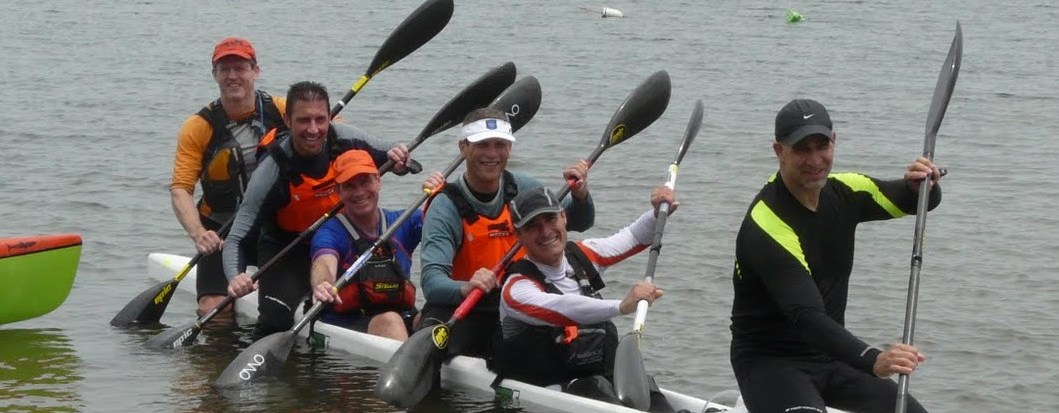
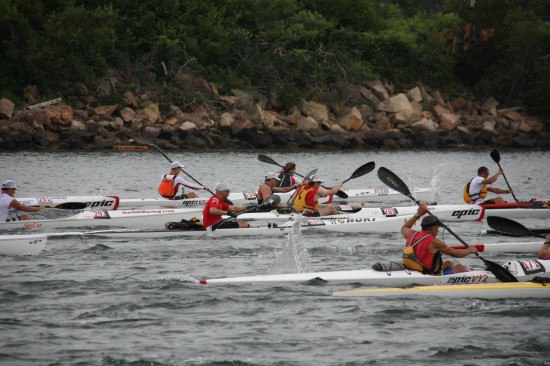
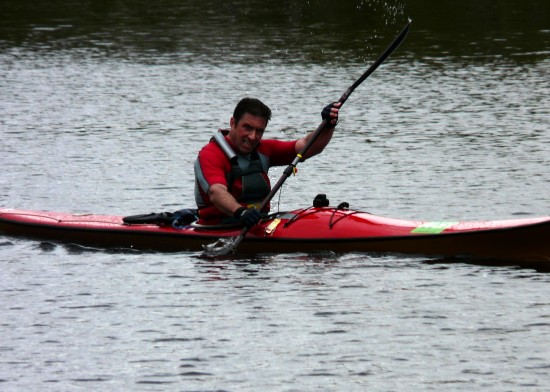
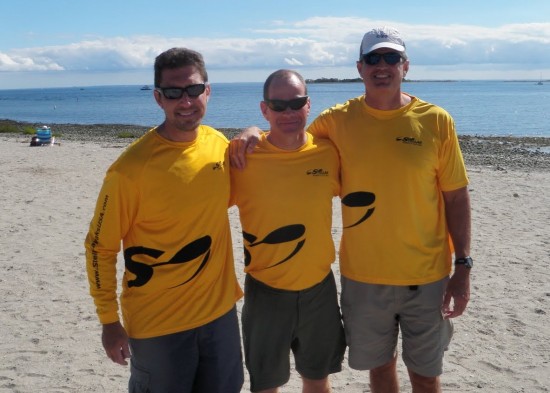
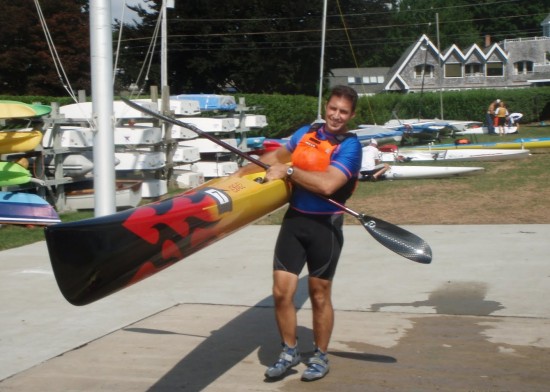
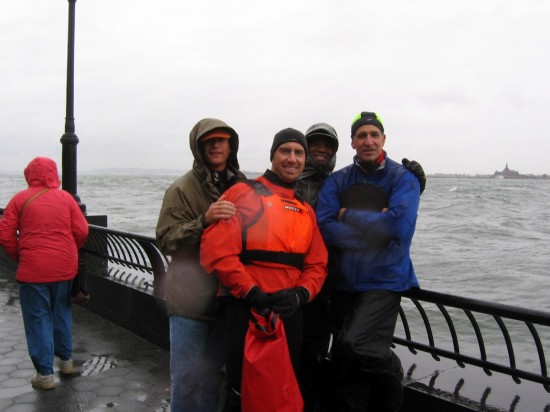
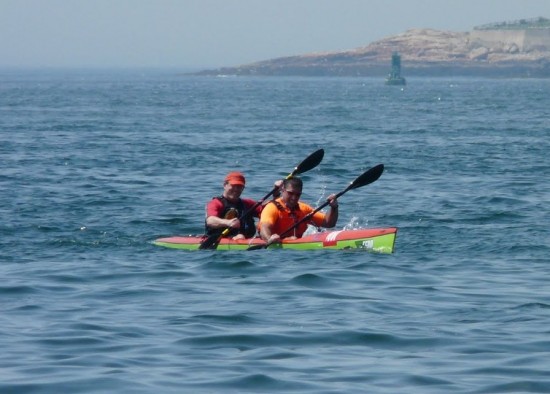
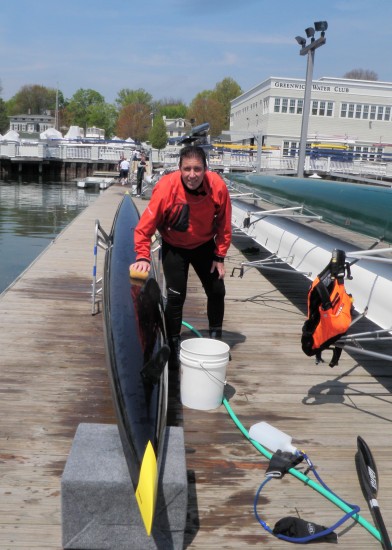
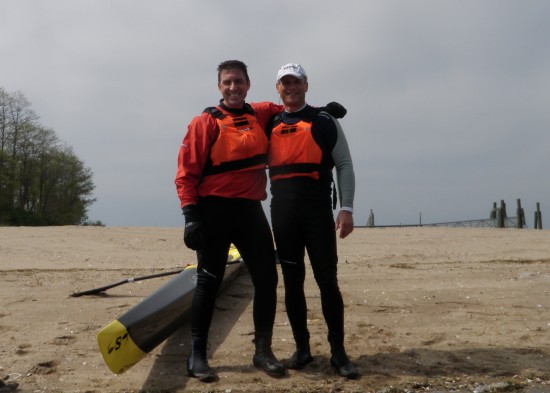
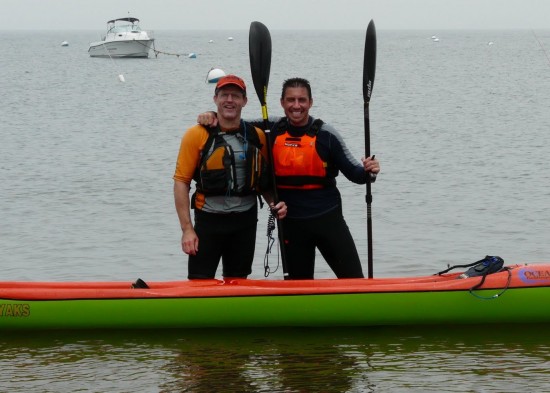
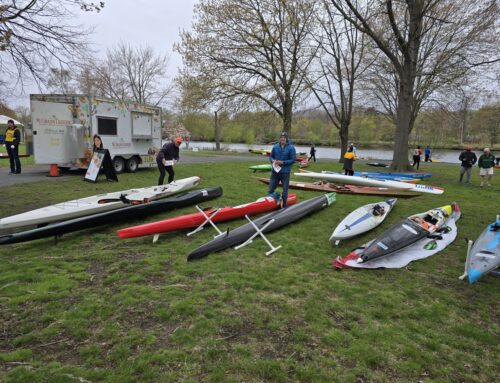
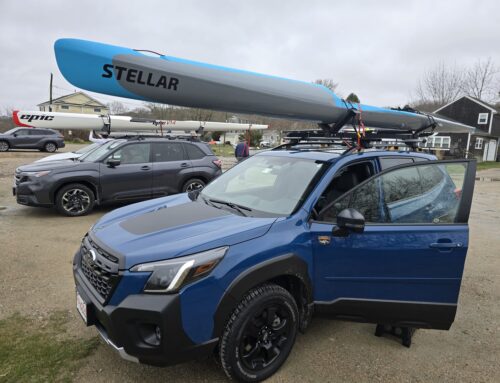
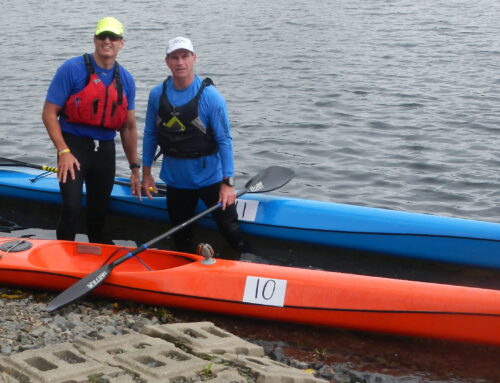
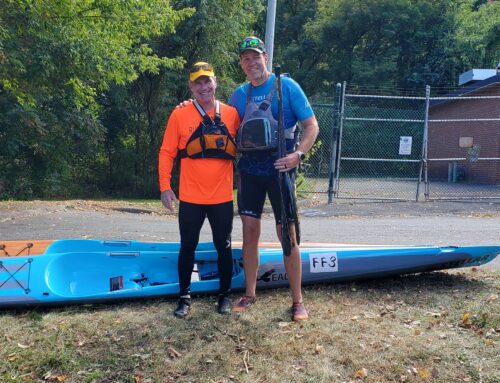
Leave A Comment
You must be logged in to post a comment.